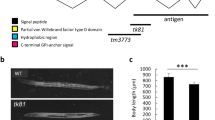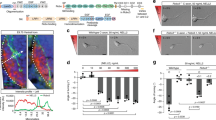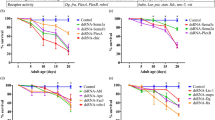Abstract
Commissureless (Comm) controls axon guidance across the Drosophila melanogaster midline by regulating surface levels of Robo, the receptor for the midline repellent Slit. Two different models have been proposed for how Comm regulates Robo: a 'sorting' model and a 'clearance' model, both based on studies using heterologous cells in vitro. Here, we test these two models in vivo. We establish a genetic rescue assay for Comm, and use this assay to show that midline crossing does not require the presence of Comm in midline cells, as proposed by the clearance model. Moreover, by monitoring the trafficking of a Robo–green fluorescent protein (GFP) fusion in living embryos, we demonstrate that Comm prevents the delivery of Robo-GFP to the growth cone, as predicted by the sorting model. It has also been suggested that Comm must be ubiquitinated by the Nedd4 ubiquitin ligase. We show here, however, that ubiquitination of Comm is not required for its function in vitro or in vivo, and that Nedd4 is unlikely to function in axon guidance at the midline.
This is a preview of subscription content, access via your institution
Access options
Subscribe to this journal
Receive 12 print issues and online access
$209.00 per year
only $17.42 per issue
Buy this article
- Purchase on Springer Link
- Instant access to full article PDF
Prices may be subject to local taxes which are calculated during checkout





Similar content being viewed by others
References
Dickson, B.J. Molecular mechanisms of axon guidance. Science 298, 1959–1964 (2002).
Kidd, T., Bland, K.S. & Goodman, C.S. Slit is the midline repellent for the robo receptor in Drosophila. Cell 96, 785–794 (1999).
Long, H. et al. Conserved roles for Slit and Robo proteins in midline commissural axon guidance. Neuron 42, 213–223 (2004).
Keleman, K. et al. Comm sorts robo to control axon guidance at the Drosophila midline. Cell 110, 415–427 (2002).
Georgiou, M. & Tear, G. Commissureless is required both in commissural neurones and midline cells for axon guidance across the midline. Development 129, 2947–2956 (2002).
Seeger, M., Tear, G., Ferres-Marco, D. & Goodman, C.S. Mutations affecting growth cone guidance in Drosophila: genes necessary for guidance toward or away from the midline. Neuron 10, 409–426 (1993).
McGovern, V.L. & Seeger, M.A. Mosaic analysis reveals a cell-autonomous, neuronal requirement for Commissureless in the Drosophila CNS. Dev. Genes Evol. 213, 500–504 (2003).
Kidd, T., Russell, C., Goodman, C.S. & Tear, G. Dosage-sensitive and complementary functions of roundabout and commissureless control axon crossing of the CNS midline. Neuron 20, 25–33 (1998).
Bonkowsky, J.L., Yoshikawa, S., O'Keefe, D.D., Scully, A.L. & Thomas, J.B. Axon routing across the midline controlled by the Drosophila Derailed receptor. Nature 402, 540–544 (1999).
Tear, G. et al. commissureless controls growth cone guidance across the CNS midline in Drosophila and encodes a novel membrane protein. Neuron 16, 501–514 (1996).
Myat, A. et al. Drosophila Nedd4, a ubiquitin ligase, is recruited by Commissureless to control cell surface levels of the roundabout receptor. Neuron 35, 447–459 (2002).
Georgiou, M. & Tear, G. The N-terminal and transmembrane domains of Commissureless are necessary for its function and trafficking within neurons. Mech. Dev. 120, 1009–1019 (2003).
Boll, W. & Noll, M. The Drosophila Pox neuro gene: control of male courtship behavior and fertility as revealed by a complete dissection of all enhancers. Development 129, 5667–5681 (2002).
Wharton, K.A. Jr., & Crews, S.T. CNS midline enhancers of the Drosophila slit and Toll genes. Mech. Dev. 40, 141–154 (1993).
Wharton, K.A., Jr., Franks, R.G., Kasai, Y. & Crews, S.T. Control of CNS midline transcription by asymmetric E-box-like elements: similarity to xenobiotic responsive regulation. Development 120, 3563–3569 (1994).
Mitchell, K.J. et al. Genetic analysis of Netrin genes in Drosophila: Netrins guide CNS commissural axons and peripheral motor axons. Neuron 17, 203–215 (1996).
Hirokawa, N. Kinesin and dynein superfamily proteins and the mechanism of organelle transport. Science 279, 519–526. (1998).
Goldstein, L.S. & Yang, Z. Microtubule-based transport systems in neurons: the roles of kinesins and dyneins. Annu. Rev. Neurosci. 23, 39–71 (2000).
Overly, C.C. & Hollenbeck, P.J. Dynamic organization of endocytic pathways in axons of cultured sympathetic neurons. J. Neurosci. 16, 6056–6064 (1996).
Helliwell, S.B., Losko, S. & Kaiser, C.A. Components of a ubiquitin ligase complex specify polyubiquitination and intracellular trafficking of the general amino acid permease. J. Cell Biol. 153, 649–662 (2001).
Soetens, O., De Craene, J.O. & Andre, B. Ubiquitin is required for sorting to the vacuole of the yeast general amino acid permease, Gap1. J. Biol. Chem. 276, 43949–43957 (2001).
Hicke, L. & Dunn, R. Regulation of membrane protein transport by ubiquitin and ubiquitin-binding proteins. Annu. Rev. Cell Dev. Biol. 19, 141–172 (2003).
Bashaw, G.J., Kidd, T., Murray, D., Pawson, T. & Goodman, C.S. Repulsive axon guidance: Abelson and Enabled play opposing roles downstream of the Roundabout receptor. Cell 101, 703–715 (2000).
Fan, X., Labrador, J.P., Hing, H. & Bashaw, G.J. Slit stimulation recruits Dock and Pak to the roundabout receptor and increases Rac activity to regulate axon repulsion at the CNS midline. Neuron 40, 113–127 (2003).
Lee, H. et al. The microtubule plus end tracking protein Orbit/MAST/CLASP acts downstream of the tyrosine kinase Abl in mediating axon guidance. Neuron 42, 913–926 (2004).
Hsouna, A., Kim, Y.S. & VanBerkum, M.F. Abelson tyrosine kinase is required to transduce midline repulsive cues. J. Neurobiol. 57, 15–30 (2003).
Ryder, E. et al. The DrosDel collection: a set of P-element insertions for generating custom chromosomal aberrations in Drosophila melanogaster. Genetics 167, 797–813 (2004).
Macias, M.J., Wiesner, S. & Sudol, M. WW and SH3 domains, two different scaffolds to recognize proline-rich ligands. FEBS Lett. 513, 30–37 (2002).
Brand, A.H. & Perrimon, N. Targeted gene expression as a means of altering cell fates and generating dominant phenotypes. Development 118, 401–415 (1993).
Hummel, T., Schimmelpfeng, K. & Klambt, C. Commissure formation in the embryonic CNS of Drosophila: I. Identification of the required gene functions. Dev. Biol. 209, 381–398 (1999).
Berger, J. et al. Genetic mapping with SNP markers in Drosophila. Nat. Genet. 29, 475–481 (2001).
Rajagopalan, S., Vivancos, V., Nicolas, E. & Dickson, B.J. Selecting a longitudinal pathway: Robo receptors specify the lateral position of axons in the Drosophila CNS. Cell 103, 1033–1045 (2000).
Acknowledgements
We thank G. Tear, M. Noll, C. Klämbt, R. Hiesinger, and the Drosdel consortium for fly stocks; A. Graf and K. Paiha for technical assistance; and F. Schnorrer and G. Gilestro for discussions and comments on the manuscript. This work was funded in part by a grant from the Austrian Science Foundation (FWF). C.R. is supported by an EMBO long-term postdoctoral fellowship.
Author information
Authors and Affiliations
Corresponding author
Ethics declarations
Competing interests
The authors declare no competing financial interests.
Supplementary information
Supplementary Fig. 1
Models for Comm function in midline crossing. (JPG 125 kb)
Supplementary Video 1
False-color time-lapse of a living stage 16 embryo expressing Robo-GFP under the control of the poxn-GAL4 driver. PNS axons were scanned at 2.2-second intervals. To improve the signal-to-noise ratio the axon was bleached after 8.8 seconds. Growth cones are to the right. (MOV 2663 kb)
Supplementary Video 2
False-color time-lapse of a living stage 16 embryo expressing Robo-GFP under the control of the poxn-GAL4 driver. PNS axons were scanned at 5.4-second intervals. Growth cones are to the right. (MOV 3946 kb)
Supplementary Video 3
False-color time-lapse of a living stage 16 embryo expressing Robo-GFP under the control of the poxn-GAL4 driver. PNS axons were scanned at 3-second intervals. To improve the signal-to-noise ratio the axon was bleached after 24 seconds and after 5 minutes and 27 seconds. Growth cones are to the right. (MOV 4180 kb)
Supplementary Video 4
False-color time-lapse of a living late-stage 15 embryo expressing Robo-GFP and Comm under the control of the poxn-GAL4 driver. PNS axons were scanned at 8-seconds intervals. Growth cones are to the right. (MOV 2118 kb)
Supplementary Video 5
False-color time-lapse of a living late-stage 15 embryo expressing Robo-GFP and Comm under the control of the poxn-GAL4 driver. PNS axons were scanned at 8-seconds intervals. Growth cones are to the right. (MOV 2005 kb)
Rights and permissions
About this article
Cite this article
Keleman, K., Ribeiro, C. & Dickson, B. Comm function in commissural axon guidance: cell-autonomous sorting of Robo in vivo. Nat Neurosci 8, 156–163 (2005). https://doi.org/10.1038/nn1388
Received:
Accepted:
Published:
Issue Date:
DOI: https://doi.org/10.1038/nn1388
This article is cited by
-
Commissural axon guidance in the developing spinal cord: from Cajal to the present day
Neural Development (2019)
-
Roles of axon guidance molecules in neuronal wiring in the developing spinal cord
Nature Reviews Neuroscience (2019)
-
In vivo functional analysis of Drosophila Robo1 immunoglobulin-like domains
Neural Development (2016)
-
Transcriptional regulation of guidance at the midline and in motor circuits
Cellular and Molecular Life Sciences (2014)
-
Identifying targets of the Sox domain protein Dichaete in the Drosophila CNS via targeted expression of dominant negative proteins
BMC Developmental Biology (2013)



